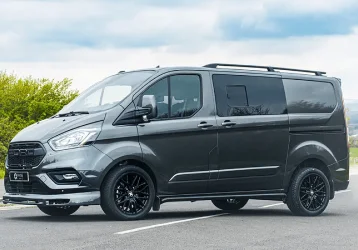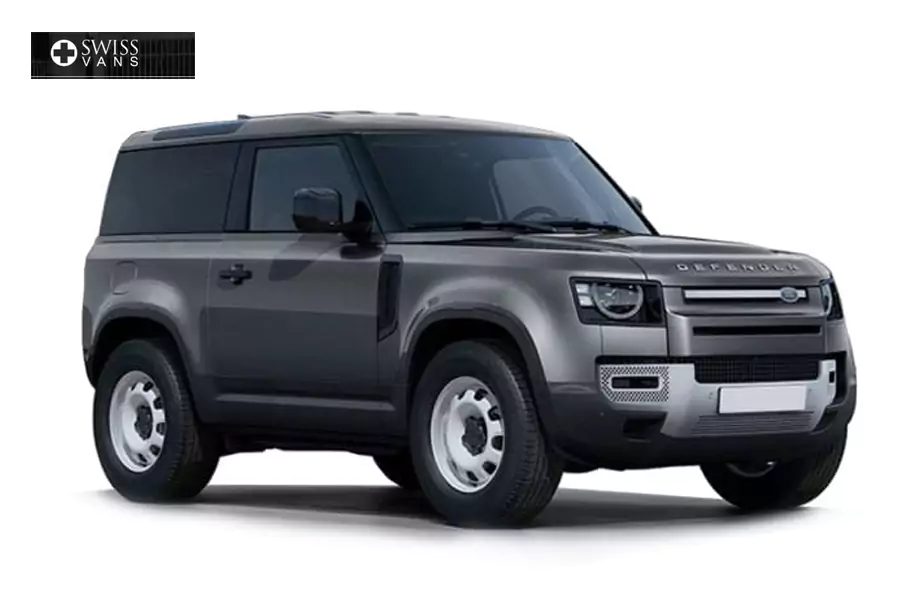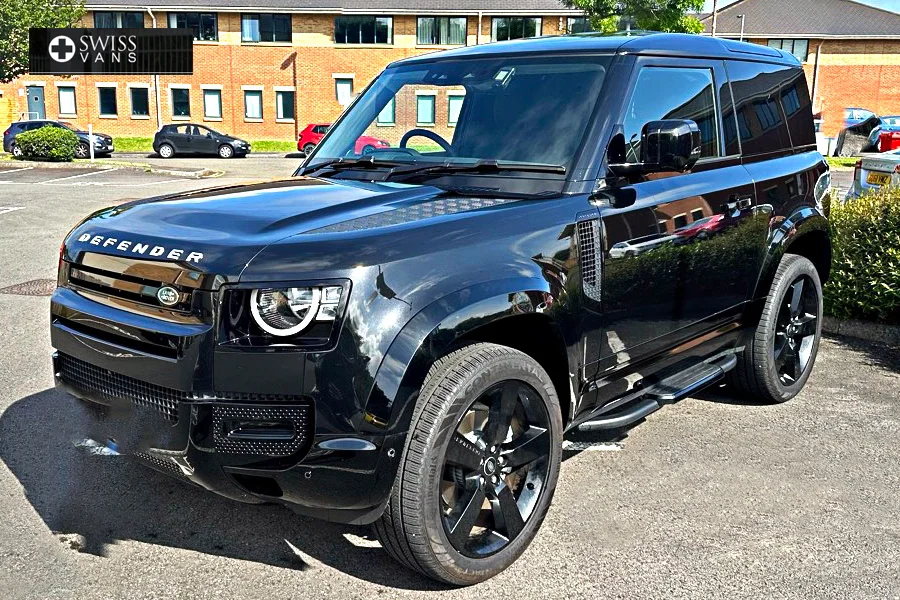Land Rover
New Land Rover Commercial
Let’s divide the room. There are two categories. HardTop, which is commercial. Non-HardTop which isn’t. The Land Rover Defender has so many options. It’s bursting with unforgettable versatility and premium choices for everyone from families with children to companies needing to ferry around the crew and supplies.
Hard Top Commercial
We have no idea where the name HardTop came from, but it has no relation to 2022. Maybe it’s a romantic reference to when the LRDG roamed across North Africa in open-top Land Rovers with twin Vickers and a Browning mounted in unison back in the 1940s.
Stowability and seating
The rugged and durable Land Rover Commercial HardTop is a 4×4 with a unique, unstoppable combination of off-road capability. The HardTop has two different body designs — the 90 and 110 versions. Both versions give you two front seats, possibly three, named a jump seat. As for stowability, the 90 provides up to 1,355 litres of cargo space, and the 110 gives up to 2,059 litres. If you need more space, you can tow an additional 3,500 kg behind you with the same versatility thanks to advanced tow assist technology that helps you during reversing manoeuvres. Behind the full-height bulkhead partition, the cargo area has rubber floor coverings throughout, lashing points, hooks, and even lockable storage under the floor. The underfloor space gives an additional 58 litres at the rear of both versions. The 110 version includes an additional floor space where the footwells are normally found in the passenger model — providing up to 155 litres of additional hidden space. The 90 and the 110 version is a little odd in that it creates a little storage room in the middle and where the seats used to be.
Power and traction
Powered by bold and efficient Ingenium diesel engines, 8-speed automatic transmission, and Intelligent All-Wheel Drive, you have all the power and traction you will need to go anywhere the job takes you with ease. As a bonus, the Defender can ford up to 900 mm, allowing you to barrel through mud, sand, and water with the same ease as a drive on any city road.
Technology galore
In addition to the tow reversal technology, the Defender has tons of other options, giving you the latest in connected technologies. These include enhancements for visibility, such as Clearsight Rearview and a 3D Surround camera to make tight manoeuvres and off-roading easier. Though not really tech, you can make it easier to advertise your business with a bespoke sign behind the front row of seats all the way to the rear of the van.
Both versions are VAT friendly!
Non-commercial
The non-HardTop alternatives come in the form of the Land Rover 90, 110, or 130. This Land Rover features a sliding panoramic roof, premium LED headlights with signature DRL, and heated power fold door mirrors including approach lights and an auto-dimming feature on the driver side. There are several models to choose from, meaning there is sure to be a Defender out there for everyone. But its not a van
Power and traction
The Land Rover Defender comes with a 3.0 litre diesel with a maximum of 249 hp and an automatic transmission. It has a Twin-speed transfer box and Terrain Response capabilities. You can also get the Defender as an electric hybrid if you like. The hybrid can go an impressive 51 km on a full charge. The Defender will be able to wade through up to 900 mm of mud and water, just like the Hard Top. The electrically controlled 4×4 will help you grip any surface — even with an approach angle of 37.5 degrees, effortlessly.
Interior and stowability
The Land Rover Defender will seat up to 8 people, given that you select the 130 version. If your focus is on hauling things instead of people, the Land Rover Defender has a load space of up to 1,263 kg behind the first row of seats, or 297 kg if you start from behind the second row. It will tow up to 3,500 kg for those times when you just need more space to bring camping gear or supplies. For even more space, the Defender comes equipped with the ability to haul another 118 kg on the roof. Each model comes with different choices of leather seats — some of which include heating and cooling features and an armrest for the captain’s seat. The top package, 130 First Edition, has impressive features like front fog lights, privacy glass, dark oak veneer that is naturally smoked, a refrigerator in the centre console compartment, a heated leather steering wheel, an air quality sensor, and a cabin air purification system, and so much more.
Tech for all your needs
Depending on the options of model and body style you choose, there is so much technology to help you stay connected and take your Land Rover on even the most remote terrain. The DriverAssist programmes consist of blind spot assistance, 360-degree parking aids, wade sensing, emergency braking, 3D surround camera, and so much more. There is an 11.4” touchscreen infotainment system with Pivi Pro to provide all the needs you may have. The top package even includes wireless device charging, keyless entry, and a list of other goodies. For those wild trips where you want a personal soundtrack to help fuel your adventure, you can even get the option of a Meridian sound system with 10 speakers, plus a subwoofer — allowing you to jam out while going over rock, mud, hills, snow, ice, rain, or any other off-road playground you want.
Get your Land Rover today
Land Rover seems to prefer foreign markets to the UK. They sell very well abroad, and often for higher prices. This affects the level of discounts in the UK. It’s a very desirable product. Often, Land Rover Defender a few months old sells for more than new ones. Here at Swiss Vans, we make it easy to take home your choice of Land Rover — whether you want one or a whole fleet of these off-road beasts. Come on in to talk to us about financing options. Find out how we can help you purchase, lease hire, contract hire, or even rent a van today.
The History of Land Rover
Land Rover, the iconic British automotive brand, has a rich and fascinating history that spans over seven decades. Since its inception, Land Rover has been synonymous with ruggedness, durability, and off-road capability. From humble beginnings to becoming a global luxury SUV powerhouse, the brand has left an indelible mark on the automotive industry. Let’s delve into the captivating story of Land Rover.
Origins and Early Years (1947-1970): The origins of Land Rover can be traced back to the aftermath of World War II when Maurice Wilks, the chief designer at Rover, had an idea to create a versatile and robust vehicle for agricultural and light industrial purposes. Inspired by the surplus Willys Jeeps used during the war, Wilks sketched the first Land Rover on the beach in Anglesey, Wales.
In 1947, the Land Rover made its debut at the Amsterdam Motor Show. The Series I, as it was known, featured a simple design with an aluminum body, a sturdy ladder chassis, and a powerful four-cylinder engine. It was an instant success, capturing the imagination of people who needed a capable off-road vehicle.
Over the next two decades, Land Rover expanded its lineup with various models. The Series II arrived in 1958, featuring more refined styling and improved creature comforts. It was followed by the Series IIA in 1961, which introduced more powerful engines and further enhancements to suspension and drivetrain.
The Series III, introduced in 1971, marked the end of an era for Land Rover. It was the last model to bear the “Series” name and represented the pinnacle of the original Land Rover design.
Expansion and Evolution (1970-1994): In 1970, Land Rover became a separate entity within the British Leyland conglomerate. The company embarked on a journey of expansion and modernization.
One of the significant milestones during this period was the introduction of the Range Rover in 1970. Unlike the utilitarian Series models, the Range Rover was positioned as a more luxurious and versatile vehicle, combining off-road capability with on-road comfort. Its innovative blend of ruggedness and refinement created a new market segment for luxury SUVs.
The Range Rover’s success prompted Land Rover to diversify further. In 1971, the lightweight and nimble Series III-based Land Rover 88 and 109 models were introduced. These vehicles targeted customers who desired a more compact and maneuverable off-roader.
Throughout the 1980s, Land Rover continued to innovate. The introduction of the Land Rover Ninety and One Ten in 1983 showcased the brand’s commitment to creating vehicles suitable for a wide range of purposes and environments. These models boasted improved ergonomics, increased interior space, and refined drivetrains.
The Defender Era (1983-2016): In 1983, the Land Rover One Ten and Ninety were rebranded as the Land Rover Defender. The Defender nameplate became synonymous with Land Rover’s uncompromising off-road capabilities, longevity, and go-anywhere attitude.
The Defender received numerous updates and improvements over the years, including engine upgrades, cosmetic refinements, and technological advancements. Despite its continuous evolution, the Defender retained its iconic boxy design, making it instantly recognizable worldwide.
Land Rover also ventured into the luxury SUV segment during the 1990s. The Discovery, launched in 1989, combined off-road prowess with comfort and refinement, attracting a new demographic of customers seeking adventure and style.
The Modern Era and Beyond (1994-Present): In 1994, Land Rover became part of the BMW Group, followed by subsequent ownership by Ford Motor Company and later Tata Motors. These changes in ownership brought fresh investment and renewed focus on product development.
The 21st century witnessed Land Rover’s expansion into new territories. The Freelander, introduced in 1997, targeted the compact SUV segment, blending urban practicality with off-road capabilities.
In 2004, Land Rover unveiled the Range Rover Sport, a more dynamic and sport-oriented alternative to the flagship Range Rover. The Range Rover Sport’s success solidified Land Rover’s position in the luxury SUV market.
Land Rover’s commitment to innovation and sustainability became evident in 2011 when the Range Rover Evoque was introduced. The Evoque showcased a bold and contemporary design, coupled with lightweight construction and fuel-efficient engines.
In recent years, Land Rover has embraced electric mobility. The all-electric Jaguar I-PACE, launched in 2018, laid the foundation for Land Rover’s electrification plans. Subsequently, Land Rover introduced plug-in hybrid versions of the Range Rover and Range Rover Sport, demonstrating its dedication to a greener future.
Today, Land Rover offers a diverse lineup of luxury SUVs that cater to various customer preferences. The Range Rover family, including the flagship Range Rover, Range Rover Sport, and Range Rover Velar, represents the epitome of luxury and capability. The Discovery and Defender models continue to embody the brand’s spirit of adventure and versatility.
Land Rover’s legacy as a pioneering force in the off-road segment, combined with its ability to adapt to changing times, has propelled it to the forefront of the global automotive industry.
In Conclusion: From its humble beginnings in 1947 to its current status as a renowned luxury SUV manufacturer, Land Rover has built a legacy that embodies exploration, adventure, and resilience. The brand’s unwavering commitment to off-road capability, innovation, and design has made Land Rover an iconic symbol of British engineering excellence. As Land Rover continues to evolve and embrace new technologies, it remains true to its heritage while venturing into a future of sustainable mobility.
- Filter
 Storage Systems
£24
Business leasing exc VAT per month Initial rental £24.00 exc VAT 24 months-5000 miles per year
View More
Special Offer
In Stock
Storage Systems
£24
Business leasing exc VAT per month Initial rental £24.00 exc VAT 24 months-5000 miles per year
View More
Special Offer
In Stock
 Land Rover Defender Commercial 5/6 Seater Conversions
£799
Business leasing exc VAT per month Initial rental £799.00 exc VAT 24 months-5000 miles per year
View More
Special Offer
In Stock
Land Rover Defender Commercial 5/6 Seater Conversions
£799
Business leasing exc VAT per month Initial rental £799.00 exc VAT 24 months-5000 miles per year
View More
Special Offer
In Stock
 Land Rover Defender Hard Top 110
£699
Business leasing exc VAT per month Initial rental £699.00 exc VAT 24 months-5000 miles per year
View More
Special Offer
In Stock
Land Rover Defender Hard Top 110
£699
Business leasing exc VAT per month Initial rental £699.00 exc VAT 24 months-5000 miles per year
View More
Special Offer
In Stock
 New Land Rover Defender 90
£699
Business leasing exc VAT per month Initial rental £699.00 exc VAT 24 months-5000 miles per year
View More
New Land Rover Defender 90
£699
Business leasing exc VAT per month Initial rental £699.00 exc VAT 24 months-5000 miles per year
View More
Swiss Vans
Why Lease With Swiss Vans
The Best Price
Our Price Promise guarantees you the very best deal".
Flexible Options
Choose the mileage, length of contract and initial payment to suit you.
No Hidden Fees
We don't charge admin fees & have a free 30-day returns policy.
Expert Advice
Our experts are on hand for any info you need about leasing.




